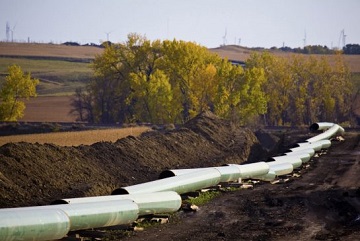Keystone XL pipeline won't drive up greenhouse gas emissions, U.S. State Department says

Canada’s controversial Keystone XL pipeline moved one step nearer to reality Friday with a U.S. government assessment that the project will have little to no impact on American greenhouse gas emissions.
The long-awaited U.S. State Department report — hailed in Ottawa and Alberta, shredded by the project’s environmental opponents — set in motion a new countdown that is expected to prompt a final decision from President Barack Obama by July.
The dense technical review, a draft environmental impact assessment numbering hundreds of pages of detailed analysis, offered no conclusions on the overall merits of the pipeline, which would as much as double the southern flow of diluted oilsands bitumen to the U.S. But one key finding — the assessment that Canada’s oilsands and American demand for heavy crude will proceed apace, with or without Keystone XL — proved an instant flashpoint, with political rejoicing in Canada and environmental fury south of the border.
Alberta Premier Alison Redford welcomed the report, saying: “We respect the U.S. decision-making process and fully expect the president’s final decision will be extremely well thought out and based on science and fact. I believe today’s report is another step in that direction.”
Cooper Matheson, special assistant to Alberta Energy Minister Ken Hughes, tweeted that the report amounted to a “thumbs up” from the state department. “Very favourable overall,” he wrote.
In Ottawa, Harper government officials couched their relief in careful language, with Natural Resources Minister Joe Oliver issuing a statement hailing a binational commitment to “shared prosperity, energy security and environmental stewardship.”
Canada will review the report, said Oliver, just as “the United States has a process for reviewing the project and we respect their process.”
Keystone’s leading stateside opponents registered broad disappointment, calling the report “flawed, perplexing and inaccurate” and vowing more months of protest to ramp up pressure on Obama and Secretary of State John Kerry.
Bill McKibben of environmentalist group 350.org said the State Department findings fly in the face of Canadian industry experts who “acknowledge openly” that halting the pipeline will effectively halt oilsands development.
“This is Groundhog Day,” he said. “We’re hearing the same rehashed arguments from the State Department about why a great threat to the climate is not a threat at all.”
Michael Brune, executive director of the Sierra Club, said that while there is “no sign of White House fingerprints on this analysis,” the report nevertheless complicates Obama’s decision.
“The president needs to reconcile his soaring rhetoric on climate with strong action — and today the State Department made his job that much more difficult,” Brune said.
Anti-Keystone activists welcomed one dimension of the draft report — an acknowledgment, based on the 2010 Kalamazoo River oil spill, that heavy Alberta bitumen behaves differently in water than conventional oil, requiring a different cleanup response.
The newly released draft documents, to be formally published next week by the U.S. Environmental Protection Agency, sets a new timeline, with 45 days for public comment — including at least one more public meeting in Nebraska, where opposition over risks to a key Midwest watershed, the Ogallala Aquifer, forced TransCanada pipeline planners to remap the project.
The State Department, which holds jurisdiction because of the border-crossing nature of the pipeline, is then expected to issue a final report, including a “National Interest Determination” weighing the overall merits of the project.
In remains unclear what degree of influence Kerry, a longtime champion of the climate issue in Washington, will bring to bear on the politics of Keystone. But as before, the final decision belongs to Obama alone.
You can return to the main Market News page, or press the Back button on your browser.

